One day in 2010, a vigilant motorist came upon an ailing red-tailed hawk along a New York highway. Consequent to the traveler’s efforts, the bird, which was unable to fly, eventually arrived at The Raptor Trust, in Millington, NJ, to be admitted for treatment and rehabilitation. During the last fifty years, hundreds of thousands of hawks and other raptors have been banded—fitted with an identifying bracelet around a leg—in order to aid research about their life habits. The number on this red-tail’s band revealed that it had been applied in 1983, her first year of life, and that the band was issued by Len Soucy, the founder of this same Raptor Trust. It was in fact that year, 1983, when The Raptor Trust itself officially “took flight”, when Len and his wife, Diane, after fifteen years of backyard bird rehab, finally decided to incorporate their efforts as a non-profit organization that has since become one of the premier wild bird rehabilitation centers in the United States. In 2013, both the Raptor Trust and the red-tail, now called “Old Gal”, and who still resides at the center, celebrated their thirtieth birthdays.
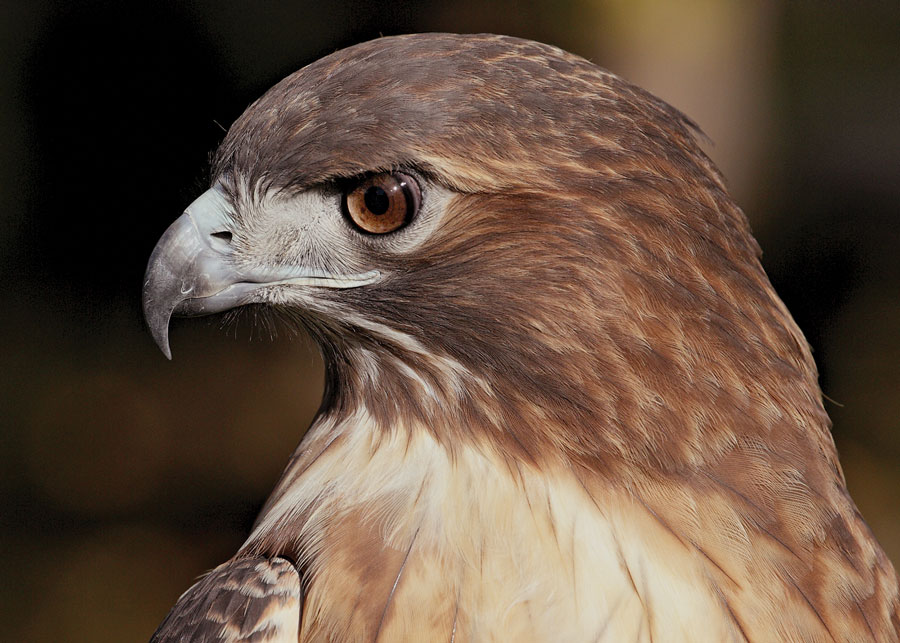
Diane first stirred Len’s avian interest when she asked for a bird feeder as a wedding present. A visit to the Hawk Mountain Sanctuary in Kempton, PA, during the fall raptor migration of 1964, inspired the couple’s special interest in birds of prey. Raptors were, at the time, generally considered nasty pests that threatened livestock, and the sanctuary was one of the few places that offered any glimpse of the birds’ magnificence. Raptors were not only freely hunted for bounty; the pesticide, DDT, had decimated many populations.
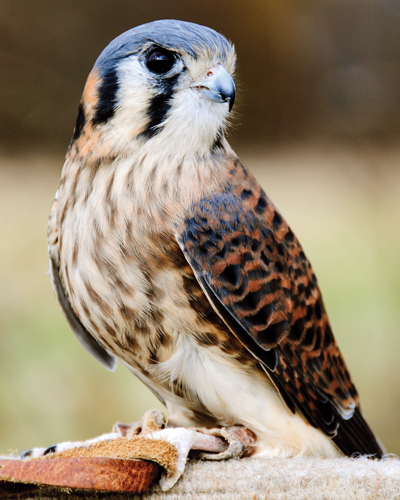
The Soucys moved to Millington in 1968 when they found fourteen wide-open acres adjoining the southwestern edge of the recently established Great Swamp National Wildlife Refuge. In addition to great excitement at the prospect of life beside the first ever Refuge Wilderness Area in America, they brought along with them their four-year-old son, Chris. Having already engaged himself in raptor research and banding, Len quickly gained some standing as “that guy in the swamp” who could fix an injured bird. The phone began to ring, and people started showing up with birds in a boxes; a Cooper’s hawk found struggling on a roadside, a cardinal that flew into a picture window, an owl caught in a chimney, or a robin that fell from the nest. As the patient rosters grew, Len began to erect enclosures for healing birds outdoors, while the family’s home served as a clinic. Until then, veterinarians had treated minor maladies for pet canaries or parakeets. But, who knew how to help a golden eagle with a broken wing? There was no established science for mending wild birds: no orthopedic surgery, no procedure for anesthetizing hollow-boned creatures, no protocol for rehabilitating birds of prey. One of Len’s banding colleagues happened to be a veterinarian, so they went about figuring it all out.
As the Soucy reputation grew, so did the number of birds brought to their backyard hospital. By the end of the 1970s hundreds of birds of all kinds, not just raptors, were admitted each year. More and more aviaries were constructed to house the burgeoning convalescent population, some of whom could not return to the wild and became permanent residents. While Len still had a “day job” as a tool and die maker, the family financed the entire project, and, along with just a few dedicated volunteers, did all the work. By the early 1980s, the project had become so large and expensive that they could no longer do it alone.
In 1982, Len and Diane established The Raptor Trust as a non-profit organization so that they could solicit funds from foundations, corporations, and private donors to support their work. And donate, they did! Money materialized to help renovate the makeshift infirmary into a more functional clinical space with an actual admitting office. More funding bought materials for an expanding complex of exterior avian apartments that began to take the shape that visitors know today. The Soucys were able to pursue other elements of their mission: to teach people about the wonders of raptors and to provide an example of humane treatment for all living things. In 1986, the Trust employed its first full-time staff member, a teacher/naturalist, and in 1988 purchased the house next door to serve as an education center. That year, Len received an Honorary Doctor of Science degree from Drew University. He has also received awards from the U.S. Fish and Wildlife Service, the U.S. Environmental Protection Agency, the New Jersey Veterinary Foundation, the Humane Society of the United States, and the National Wildlife Rehabilitators Association Lifetime Achievement Award. He has written scores of articles and pamphlets, a well-known book about New Jersey’s owls, and another soon to come about hawks.

Supported by an army of volunteers, The Raptor Trust now employs a full-time maintenance staff, three teacher/naturalists and three veterinary technicians. The Raptor Trust admitted 493 patients in 1983, a number that by 2012 grew to 4,148. They arrive 24/7 from homeowners, rescue squads, police, fire departments, and occasionally other agencies, mostly in spring and summer, baby bird season. One day in May, the infirmary took in over one hundred birds! It’s exciting when a “rock star” arrives—maybe a bald eagle or peregrine falcon—but there are thousands of non-raptorians that need attention, the majority of which are orphaned or displaced youngsters. Inside the infirmary there are dozens of nestlings, young, and many cages outside full of older fledglings and adult songbirds. Those numbers become more profound when one considers the intricacies of feeding four thousand beaks each year, sometimes every hour, and sometimes by hand. The youngest birds get special formula via syringe; older babies get berries delivered via specially modified metal spatulas. Outside, fledglings move to live insects, waterfowl get pellets and duckweed, and everyone else gets whatever else best approximates their species’ diet in the wild. And raptors get their mice, thousands of them that arrive each week, purchased from or donated by research labs around the country. Some birds need to be tube-fed, others need medication for parasites or infection. What goes in one end, comes out the other, and you probably already know how messy that can be in a bird’s case. Nest boxes must be remade at each feeding, incubators and aviaries cleaned.
When people walk into the infirmary they start to see what it takes to diagnose and care for each bird. The staff veterinary technicians evaluate with X-rays for broken bones or blood tests for poison, then triage for immediate care. Dr. Andrew Major, a volunteer veterinarian and Trust board member comes in a couple of days each week to perform surgeries and other advanced medical procedures. The techs then take over post-op care, which may even include a stay in a special intensive care unit. There are a lot of moving parts here.
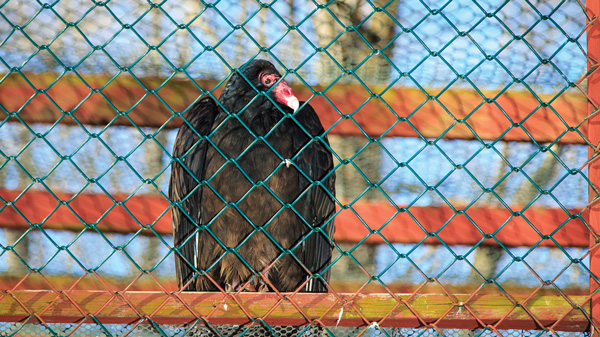
Eighty-five aviaries that contain over a quarter-million cubic feet of flight space now surround the medical infirmary. The idea, of course, is to released injured birds back into the wild, and in forty thousand cases the Trust has been successful. Some of the aviaries serve as rehabilitation quarters where recovering patients strengthen their wings, sometimes even relearning how to hunt. Although raptors are equipped with extraordinary vision that allows them to detect a rodent lounging in the grass thousands of feet below, it takes practice to get back up to snuff. And orphaned juveniles have to learn from scratch, which they do with the assistance of some of the older birds that are unable to reenter wild habitat.
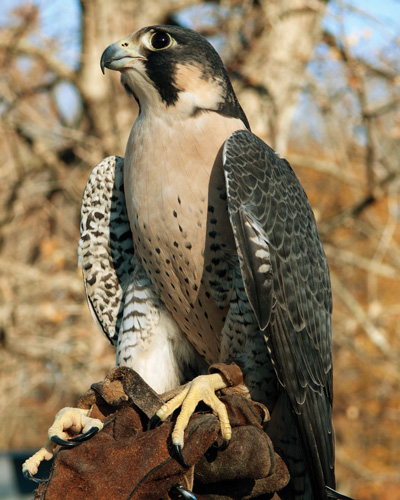
Although many species of birds eat other animals, and so would also be considered predatory, the ornithological classification of a raptor includes those particular birds of prey that have extraordinary eyesight, a sharp curved beak for tearing flesh, and strong feet with talons to hold their kill, (which is generally quite large relative to the bird’s size.) Raptors that hunt during the day (diurnal) are generally referred to as hawks, and also include birds we know as eagles, falcons, harriers, ospreys and vultures. Nocturnal raptors include nearly two hundred species of owls worldwide that hunt at night, eight of which can be found in our area. Those raptors in residence at The Raptor Trust, which number around sixty birds that are un-releasable from permanent physical or neurological impairment, have become crucial to the other half of the Soucy’s idea; to help the larger raptor population that they will never see. Thousands of people come to The Raptor Trust every year just to stroll among the aviaries, where they get a sense of how majestic these creatures are. Eyes pop wide open at the sight of a pair of bald eagles, one with only a single wing, perched twenty feet away. Georgette, a peregrine falcon found eleven years ago when she fell from her nest on top of the George Washington Bridge, has been there ever since. Though she cannot fly, her stunning presence epitomizes a species that is the fastest on earth, able to dive at over two hundred miles-per-hour. There are broad-wings that hawk watchers know from the thousands that fly overhead every day during the fall migration, and red-tails, New Jersey’s most abundant raptor, truly awesome when seen close-up. Cooper’s, sharp-shinned, merlins, goshawks, and vultures, right down to the American kestrel, whose weight is only one-fiftieth of that of a bald eagle: they’re all here. The night bird owls are more reclusive, but when seen, entirely captivating with their huge wise eyes, which like humans, are binocular in vision. A pair of snowy owls even made nesting history when they produced five chicks at their aviary. And a pair of ravens, which though not included in the raptor club, qualify for your attention as the smartest birds, in fact among the most intelligent of all animals.
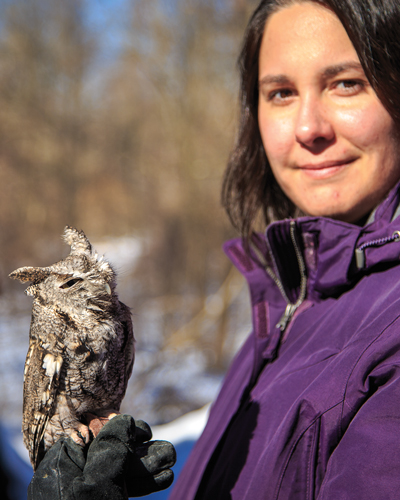
The Soucys have taken no small part in elevating raptors from vermin to royalty in the public mind, as the birds have captivated millions of nature lovers. Thirty years and 88,000 birds later, Len and Diane are ready to step back and grant stewardship to the one they trust most with the organization’s future, their son Chris, who has agreed to take on a variety of operational responsibilities with the intent of assuming leadership of the Trust. “I spent twenty-five years trying to get out of New Jersey, and another twenty-five trying to stay away,” says Chris, who after earning an undergraduate liberal arts degree from Rutgers, went to Smith College for a Master’s degree in education, then on to occupations as a teacher, musician, and most recently manager of several regional music schools in the Denver area. But, he says, “It’s in my blood. It’s part of the way I’ve viewed the world since I was a little kid. I grew up here, helped my father and my mom build some of the early cages, and do some early research on breeding populations of barn owls in Hunterdon and Somerset and on migration patterns long before the Trust was established. I watched them kind of doing it on their own, so I’ve always enjoyed and appreciated it. I don’t know that there are a lot of second generation wildlife rehabilitators; it’s got to be a pretty small group!”
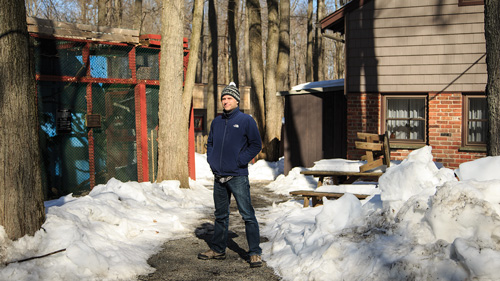
Chris’s educational expertise will surely influence the Raptor Trust’s direction in upcoming years. “My role here is not going to radically change, or fix stuff that’s not broken. I think the future is about how to share what we know. There’s information here that dates back thirty years, but is not readily available. My job is to get it out there.” Chris also has to figure out ways to repair extensive damage from a storm last October and a harsh winter. And high on the wish list at the infirmary is a digital X-ray processor. He needs to maintain a constant flow of resources for a budget that runs around $600,000 each year. If he needs help, Old Gal is always around to lend a hand.

Len Soucy died on Wednesday, June 11, 2014, and whether you knew him or not, it should matter to you. Len was an extraordinary man who made a major impact on both the wildlife of NJ and the attitudes of people living with wildlife. Services will be held on Saturday, June 28th, 1pm at the Dorothy Young Center for the Arts on the Drew University campus, Madison. In honor of this lifetime of work toward the protection and preservation of all things wild, especially birds, and the educational opportunities he labored to present to us all, Len's family has established the Leonard J. Soucy Jr. Memorial Fund for projects that would be meaningful to him. His commitment to a thriving avian population will live on, with special support for new ideas and approaches from the Memorial Fund. Donations to the fund can be directed to The Len Soucy Memorial Fund, c/o The Raptor Trust, 1390 White Bridge Rd., Millington, NJ 07946. Or at the Raptor Trust website.
The Raptor Trust Infirmary is located at 1390 White Bridge Road, Millington, NJ, 07946. Call 908/647-2353 or click their website for more information. To contact the Education Center next door please call 908/647-1091 or e-mail.
Visitors to raptor display aviaries are welcomed daily between 9am and 4:30pm; programs and groups by appointment. The infirmary is open daily to receive birds between 8am and 4:30pm (extended hours in summer months). The infirmary admitting office door is open 24-hours a day for after-hour admissions. Please park in “Bird Admitting Only” parking lot.
Please call or check the Raptor Trust website regarding these events. Some take place in locations other than The Raptor Trust facility in Millington.
Paths of green, fields of gold!
Dedicated to preserving the heritage and history of the railroads of New Jersey through the restoration, preservation, interpretation and operation of historic railroad equipment and artifacts, the museum is open Sundays, April thru October.
The Jacobus Vanderveer house is the only surviving building associated with the Pluckemin encampment.
Even today, if you needed a natural hideout—a really good one—Jonathan’s Woods could work.
Part of the Morristown National Historic Park, the formal walled garden, 200-foot wisteria-covered pergola, mountain laurel allee and North American perennials garden was designed by local landscape architect Clarence Fowler.